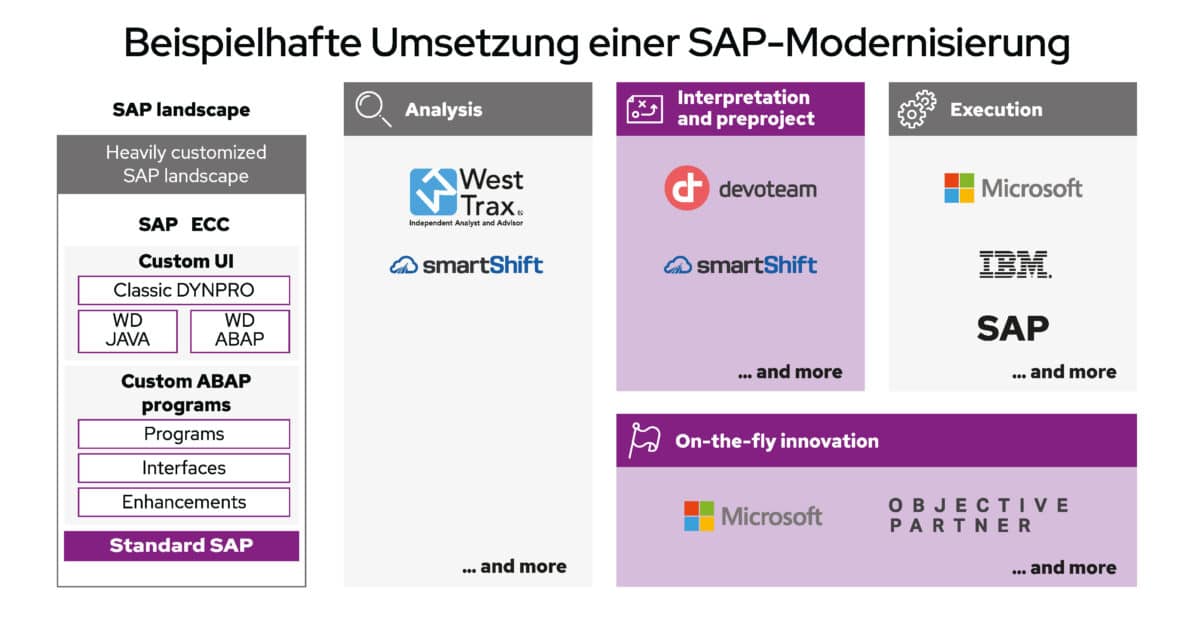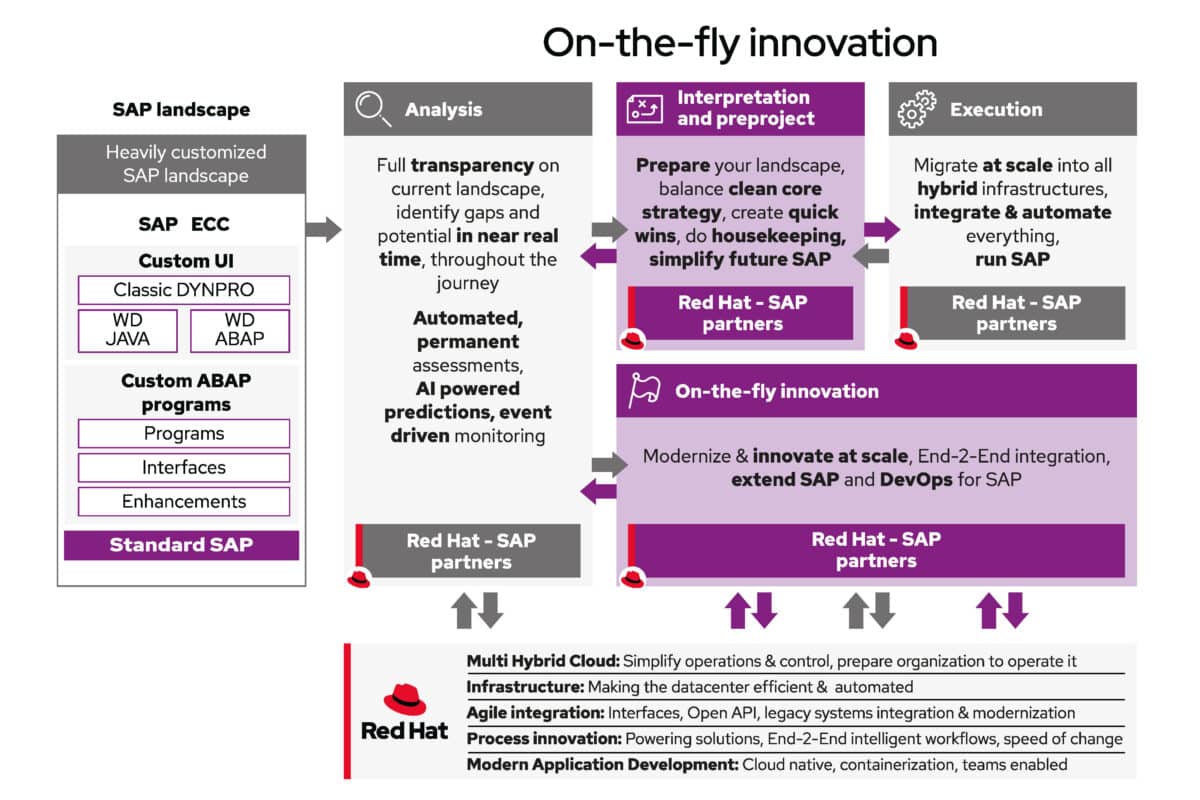On the Path to the Future SAP With an Ecosystem Toolchain: Universal Tools


More and more partners from the SAP ecosystem are using open-source principles and platforms as the methodological and technological foundation for SAP modernization within an integrated open source-based toolchain. Whether it’s Rise with SAP, Move to Cloud, or hybrid target platforms, SAP users are actively driving necessary migrations. These transformation projects are not a simple update—they are complex, time-consuming, and instead of being at the forefront, innovation is forced to take a backseat.
Pre-projects and housekeeping are reduced to a minimum out of necessity, and yet project durations remain extended. But this does not necessarily need to remain the case: Migrations can be closely integrated with modernization and innovation topics, while simultaneously being significantly accelerated. The basis for this is, in part, open-source technologies, cloud-native development models as well as certified Enterprise Kubernetes platforms and automation solutions such as Red Hat Enterprise Linux, Red Hat OpenShift and Red Hat Ansible Automation Platform. Additionally, SAP services partners as well as ISV and solution providers have been relying increasingly on precisely this foundation, when integrating the SAP landscape into an agile process environment. And the best thing about it is that the SAP ecosystem has formed a community, an integrated open source-based approach to join forces, tools, and services along the modernization journey for SAP S/4 Hana and Rise projects. Said ecosystem is an open community where more partners are welcome and can participate.
Disruption and services
As an example for a recent project, the new disruptive approach and interaction can be illustrated across modernization phases based on solutions and services from West Trax, Red Hat, Microsoft, IBM, SmartShift, Devoteam, and Objective Partners. Historically m any SAP customers used to take a step-by-step approach to transforming the SAP landscape: only after the most necessary preliminary projects and technical migration have been completed is modernization tackled. This approach corresponds to a more SAP-focused in-side-out approach, for example with a transfer of ECC systems to the cloud using the Rise-with-SAP offering, to a certain extent in line with the “lift and shift” motto. This means that customizing, or the integration and realization of outside-in added value from the non-SAP area, is postponed until the end of the migration phase. However, with the new ecosystem toolchain, there is also an alternative strategy where innovation is an integral project component of the IT migration from the very beginning.
A first step in the implementation of an SAP migration project and a core component of the SAP ecosystem toolchain for modernization is the analysis of the existing SAP system landscape. This was also the case in the past. What is new, however, is the ability to perform these analyses automatically, without workshops, and in near real-time. This is where the KPI Analyzer from the company West Trax comes into play. It is a SaaS application that helps companies evaluate their SAP systems. The Analyzer generates usage metrics to measure the health and efficiency of SAP systems. The tool not only analyzes individual aspects or modules of the SAP system, but looks at the system as a whole. For example, in terms of maturity, productivity, costs, performance, storage, quality, or security.
The KPI Analyzer also uses a benchmark database to compare and evaluate the performance of the analyzed SAP system with other systems in the same industry and across industries. On this basis, any potential for improvement can be identified. In principle, the KPI Analyzer enables companies to immediately identify the current state with weaknesses and inefficiencies in their SAP system. Initial results can be available within 30 minutes, which can serve as a recommendation for the use of solutions from the entire downstream ecosystem toolchain.

Red Hat acts as the foundation
Depending on the analysis results, a clear recommendation can be made for either modernization, selection, or addition of appropriate target platforms for suitable partner solutions. A curated enterprise open-source platform consisting of Red Hat Enterprise Linux, Red Hat OpenShift, and Red Hat Ansible Automation Platform, optimized for SAP users and partners, acts as the technological and methodological substructure for modernization and integration scenarios.
This allows operations, automation, and integration to be mapped end-to-end, weighted according to customer specifications, but always as a part of modernization. But this platform is also the foundation of an integrated ecosystem toolchain, whose defining characteristic is sharing information, facts, and insights during a concrete modernization project. Departments exchange analysis results and project parameters, everyone utilizes results and quick wins, target platform specifications and sizing are automatically transferred to the next stakeholder.
Operating SAP in the cloud is increasingly becoming a reality, but is still associated with limitations. For example, cloud providers have little insight into SAP landscapes and can, more or less, focus only on infrastructure and not on supporting companies in managing SAP. A new approach to this comes in the form of the Azure Center for SAP Solutions (ACSS), which is combined with solutions from Red Hat, such as Red Hat OpenShift and Red Hat Ansible Automation Platform—which can also be pre-connected if so desired.

S/4 Deployment
ACSS is a modern operating environment for SAP that guides users through the deployment of SAP systems, automating many steps—down to configuring the operating system, database, and security. Ultimately, ACSS "understands" the SAP landscape and monitors the status and integrity of all systems. Users can thus dispense with separate monitoring solutions. They can easily start and stop SAP systems at the push of a button and, in the future, also use services that were previously only available at the infrastructure level. These include a special Azure Backup for SAP, Azure Cost Management and Billing which supports cost optimization, and Threat Intelligence.
Again, the results of West Trax's analyses provide templates, sizing-specifications and recommendations, and meaningful Microsoft Azure services in both SAP and non-SAP contexts. Microsoft designed Azure Center for SAP Solutions as a modular and open framework that users and partners can extend and connect to other solutions. By integrating Red Hat Open-Shift and Ansible into Azure Center for SAP Solutions, enterprises and SAP ecosystem partners gain a unified foundation for developing modern, cloud-native applications and running third-party solutions that extends from the cloud to the on-premises data center and connects the SAP world with other application landscapes. Thanks to the close partnership between Red Hat and Microsoft, customers can access more than just virtual machines with Red Hat OpenShift. Billing can also be done directly through the existing Azure contract, which can notably simplify management for many customers.
IBM's tool-based Rapid Discovery methodology benefits from analytics and automation capabilities, providing a structured, functional framework for the business-focused innovation and migration of the SAP landscape. In the context of the IBM Rapid Discovery Method, the technology agnostic clean core approach is integrated. This approach places the aforementioned technical platforms and solutions in a targeted, strategic framework to enable customers to achieve a sustainably optimized SAP ecosystem. For this purpose, IBM uses its own IBM Garage approach, which is a framework for accelerating digital transformation in the SAP environment using hybrid cloud environments.
Cooperation with Red Hat and partners from the ecosystem toolchain is taking on an increasingly important role. For example, experts from IBM and SNP are jointly performing selective data migrations and data transformations in a competence center using CrystalBridge. The SNP solutions for accompanying data migration, archiving, and general data management provide an optimal basis for efficient SAP landscape migration or transformation.
The actual migration is associated with numerous technical and process-related challenges. Here, ecosystem partners provide support with various solution approaches. Ultimately, SAP landscapes are migrated to the desired target environment on a turnkey basis. Finally, many activities and transactions in SAP and the surrounding systems are subject to regulatory requirements. Recording and documenting these processes usually involves a great deal of manual effort. An example of this is the Supply Chain Act, which came into force on January 1, 2023, and sets out requirements for responsible supply chain management. Because of this, companies must connect various data sources and external information. Devoteam solutions can automate and accelerate these processes. They are delivered as Ansible Content Collection, Ansible Certified Content, and OpenShift Certified Applications, which are tested, verified, and ready to run anywhere. This creates the desired synergy of using a unified platform, regardless of the target infrastructure.
Abap Custom Code
Abap custom code in legacy systems, in particular, poses a considerable challenge during migration and modernization. Companies that have been using SAP systems for an extended period of time have a large amount of custom code that has been developed over time to support ever-changing business requirements. Much of this code can become obsolete over time as it is not designed with today's requirements in mind, such as security, performance, or maintainability. The code also presents difficulties because it is typically tightly coupled to the monolithic approach of traditional ECC 6.0 systems. A like-to-like migration would be only the first step. Moreover, in many cases the code is no longer executable in the new S/4 environments and must be adapted at great expense. With intelligent code modernization and an adequate target architecture, companies can get a handle on the challenges associated with Abap custom code, making even complex transformation projects relatively simple, quick, and cost-optimized. SmartShift, a Red Hat partner, takes on exactly these tasks with a custom code modernization, starting with the initial S/4 transformation and ending with the implementation of a clean-core SAP system. With the aforementioned KPI Analyzer, companies gain insights into SAP users’ individual challenges within a condensed timeframe. Based on this analysis, pertinent components for the migration are selected, and optimization and innovation potentials are identified. The new migration method with Red Hat additionally has many advantages. Thanks to the quick and secure platform, companies can count on a tried-and-tested and reliable migration. But how does the customer benefit from this? A quick return on investment is tangible and there is more room for innovation. Pertinent departments can also respond more quickly to market needs. Red Hat OpenShift is a particularly suitable target environment because the platform supports multiple architectures, including on-premises and edge, with a single development approach. In addition, users can easily create combined Red Hat, SAP, and non-SAP proof-of-concept environments in Microsoft Azure, for example, which significantly accelerates the implementation of end-to-end processes.






